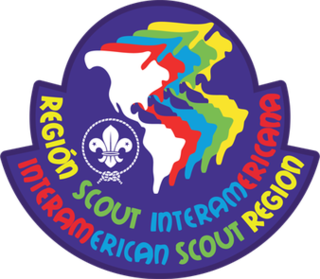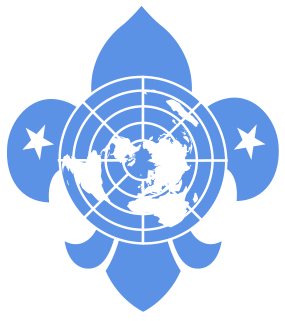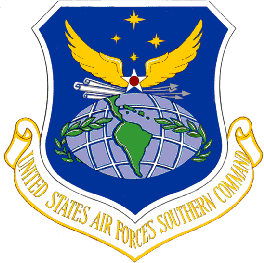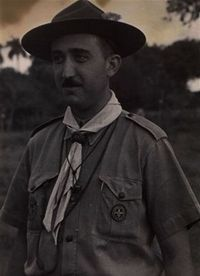
The World Organization of the Scout Movement is the largest international Scouting organization. WOSM has 172 members. These members are recognized national Scout organizations, which collectively have over 50 million participants. WOSM was established in 1922, and has its operational headquarters at Kuala Lumpur, Malaysia and its legal seat in Geneva, Switzerland. It is the counterpart of the World Association of Girl Guides and Girl Scouts (WAGGGS).

The Panama Canal Zone was an unincorporated territory of the United States from 1903 to 1979, centered on the Panama Canal and surrounded by the Republic of Panama. The zone consisted of the canal and an area generally extending five miles (8.0 km) on each side of the centerline, excluding Panama City and Colón, which otherwise would have been partly within the limits of the Zone. Its border spanned three of Panama's provinces. When reservoirs were created to assure a steady supply of water for the locks, those lakes were included within the Zone.
Balboa is a district of Panama City, located at the Pacific entrance to the Panama Canal.
Ray Orion Wyland served as national director of education and national director of the Division of Relationships for the Boy Scouts of America (BSA). He is a founding advisor to Alpha Phi Omega.

Eesti Skautide Ühing the primary national Scouting organization of Estonia, became a member of the World Organization of the Scout Movement in 1996. The coeducational Eesti Skautide Ühing has 1,337 members as of 2011.

The Scout Association of Japan is the major Scouting organization of Japan. Starting with boys only, the organization was known as Boy Scouts of Japan from 1922 to 1971, and as Boy Scouts of Nippon from 1971 to 1995, when it became coeducational in all sections, leading to neutral naming. Scouting activity decreased radically during World War II but slowly recovered; membership at the end of May 2017 was 99,779.

The Myanmar Scout Association is the national Scouting organization in Myanmar. Scouting in Myanmar was started in 1916 and disbanded in 1964 due to country's political changes; the current organization was formed in 2012 under the supervision and support of the Ministry of Education of Myanmar and became a member of the World Organization of the Scout Movement on 11 August 2016. It has about 21,007 members.

The Asociación de Scouts de Cuba was the national Scouting organization of Cuba from 1927 to 1961. Scouting in Cuba started in 1914, in 1927 the ASC was founded and became a member of the World Organization of the Scout Movement the same year and was suspended from WOSM membership in 1961. At the end of the 1950s, the boys-only association had about 6,500 members. Cuba is now one of only four of the world's independent countries that do not have Scouting.

The Interamerican Region is the divisional office of the World Scout Bureau of the World Organization of the Scout Movement, headquartered in Ciudad del Saber, Panama. The Interamerican Region services Scouting in the Western Hemisphere, both North and South America. Until the 1960s, the "Inter-American Scout Advisory Committee" serviced only Mexico, Central and South America, with Canada and the United States serviced through the then-named "Boy Scouts International Bureau" in Ottawa, Ontario, Canada. Even today, the Interamerican Region exists more for the benefit of countries south of the Rio Grande, as evidenced by the website being only in Spanish until 2011; consequently, the United States and Canada did not participate as vigorously in regional activities as do other national organizations around the world, however this is changing in the 2010s.

There have been American Scouts overseas since almost the inception of the movement, often for similar reasons as the present day. Within the Boy Scouts of America (BSA), these expatriate Scouts are now served by two overseas Councils and the Direct Service program. Within the Girl Scouts of the USA, the USAGSO serves such a purpose.

The Bharat Scouts and Guides (BSG) is the national Scouting and Guiding association of India. The national headquarters of BSG is recognised by the Government of India.

Colonel John Skinner "Belge" Wilson (1888–1969) was a Scottish scouting luminary and friend and contemporary of General Baden-Powell, recruited by him to head the International Bureau, later to become the World Bureau of the World Organization of the Scout Movement. Wilson was Acting Director from 1938 to 1939 following the death of Hubert S. Martin; he was elected in 1939 and remained in office until 1951. He then became Honorary President of WOSM for four years.

The Boy Scouts of the United Nations existed from 1945 through perhaps the early 1980s as the Scouting association serving the families of diplomats and staff of the United Nations, active in both Geneva and at Parkway Village in New York. The organization sponsored groups in India, Lebanon and Cyprus and had ties to the International Boy Scouts of the Canal Zone.
Diablo was one of many residential townships in the Panama Canal Zone. It was established in 1905 by William Luke Jenkins.
Scouting and Guiding has been popular in Panama since the 1920s. Today, it is still a tradition practiced around the country. As of 2010, Panama has 1,775 Scouts.

The United States Air Forces Southern Command is an inactive Major Command of the United States Air Force. It was headquartered at Albrook Air Force Base, Canal Zone, being inactivated on 1 January 1976.
Scouting has been active in displaced persons camps and in the lives of refugees since World War I. During and after World War II, until the early 1950s, Scouting and Guiding flourished in these camps. These Scout and Girl Guide groups often provided postal delivery and other basic services in displaced persons camps. This working system was duplicated dozens of times around the world. In the present, Scouting and Guiding once again provide services and relief in camps throughout war-torn Africa.

Salvador Fernández Beltrán D.J.C. was among the first in the Americas to receive Wood Badge training, at Gilwell Park, England. He was the first to receive honorary appointment as Deputy Camp Chief of Gilwell. With this influence, the Scouts of Cuba began to use short trousers like those worn by the English.

Due to the American-controlled Panama Canal cutting across the center of the country, Panama was of major strategic importance to the Allied war effort, as well as the most important strategic location in Latin America during World War II. It provided an invaluable link between the Atlantic and Pacific Oceans that was vital to both commerce and the defense of the Western Hemisphere. Therefore, the defense of the Canal Zone was the United States' chief concern in the American Theater. Panama never received Lend-Lease assistance, but in return for the rights to build military infrastructure within Panamanian territory, the United States undertook large-scale public works projects, which did much to modernize the country and boost the economy.














